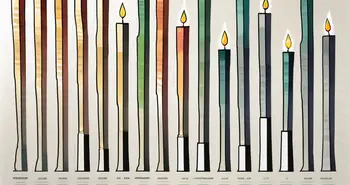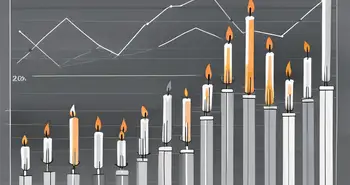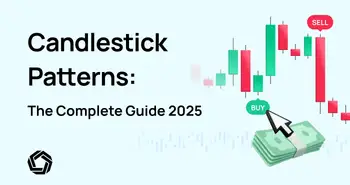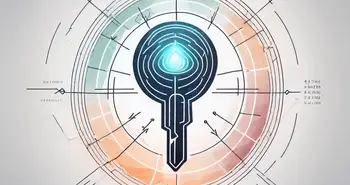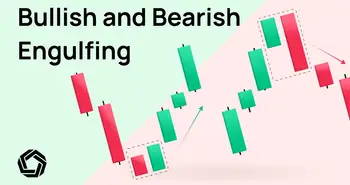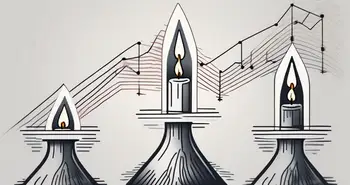Article Contents
How to Use Heikin Ashi Candles in Your Strategy
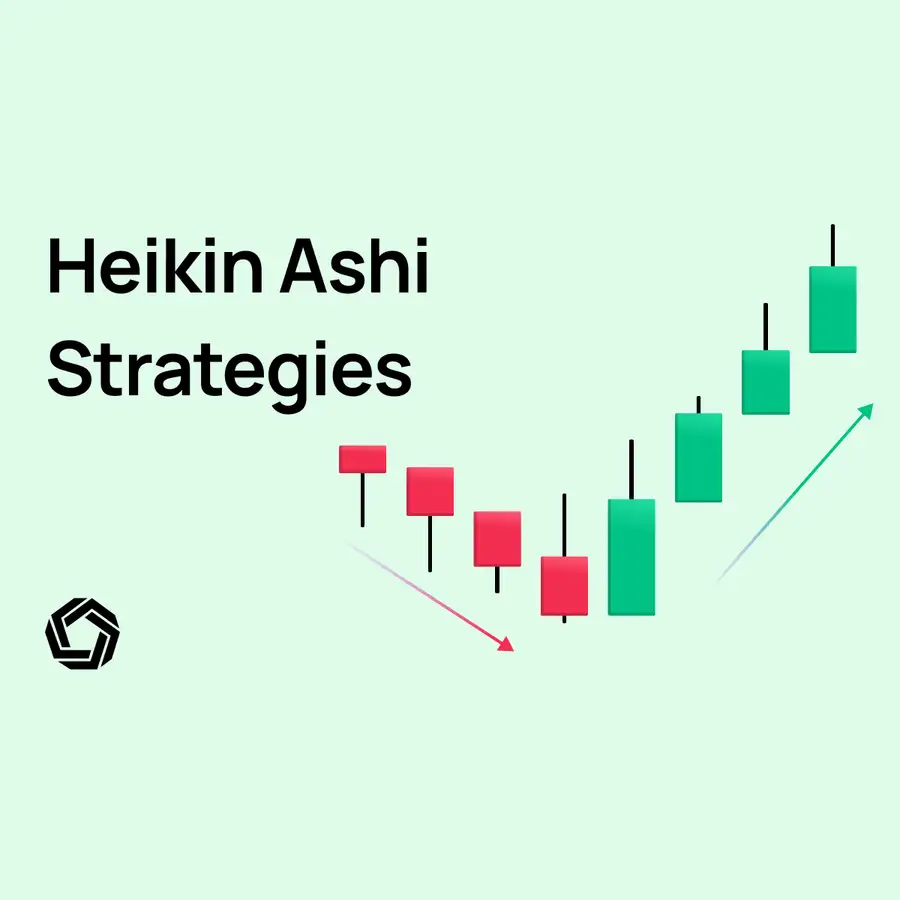
Heikin Ashi means “average bar” in Japanese, is a type of candlestick chart that aims to filter out market noise and present a clearer picture of price action.
Heikin Ashi candles are derived from traditional Japanese candlesticks, but they use a modified formula to calculate the opening, closing, high and low prices of each candle. The formula takes into account the previous candle's open and close prices, resulting in smoother and more consistent candle patterns.
So why would you use Heikin Ashi in your trading strategies? Well, Heikin Ashi charts can be particularly useful for trend-following, as they highlight trends more clearly and help you stay in trades for longer periods. Additionally, Heikin Ashi charts can help you to identify potential trend reversals and generate more accurate signals compared to traditional candlestick pattern charts.
Interestingly, Heikin Ashi charts were not developed by a famous trader or analyst, but rather by a software engineer named Dan Valcu. In the early 2000s, Valcu was experimenting with different charting techniques and came up with the idea of Heikin Ashi while working on a trading system. Since then, Heikin Ashi charts have gained popularity among traders and have become a staple in many technical analysis toolkits.
Understanding Heikin Ashi Candles
To truly understand Heikin Ashi charts, it's important to understand how they differ from traditional candlesticks. According to Dan Valcu, the creator of Heikin Ashi, there are several key differences between the two:
- Heikin Ashi candles use a modified formula to calculate the opening, closing, high and low prices of each candle, which results in a smoother and more consistent pattern compared to traditional candlesticks.
- The body of a Heikin Ashi candle is calculated using the average of the open, close, high and low prices, while the wick or shadow is determined by the actual high and low prices.
- Heikin Ashi candles are designed to filter out market noise and highlight trends more clearly, making them particularly useful for trend-following traders.
Now that we have a better understanding of how Heikin Ashi candles differ from traditional candlesticks, let's take a look at some of the characteristics of Heikin Ashi candles:
- Heikin Ashi candles are trend-following in nature, meaning that they are more likely to continue a trend rather than reverse it. This can be advantageous for traders who want to stay in a trend for longer periods.
- Heikin Ashi candles can be used to identify potential trend reversals, as the color of the candles will change from bullish to bearish or vice versa.
- Heikin Ashi candles can help traders identify support and resistance levels more clearly, as the candles tend to form smoother patterns compared to traditional candlesticks.
- Heikin Ashi candles can also be used to identify potential entry and exit points for trades, as the candles can generate more accurate trend signals compared to traditional candlesticks.
Detailed Example and Formula Breakdown
Traditional Candlestick Calculation
For traditional candlesticks, each candle is created using the actual open, high, low, and close prices of a given period (e.g., 1 hour, 1 day).
Open: The price at the beginning of the period.
Close: The price at the end of the period.
High: The highest price during the period.
Low: The lowest price during the period.
Example:
Open: $100, Close: $105, High: $110, Low: $95.
This results in a candlestick with a body ranging from $100 to $105, an upper shadow from $105 to $110, and a lower shadow from $100 to $95.
Heikin Ashi Calculation
Heikin Ashi candles use a different formula to create a smoother appearance and filter out market noise. The formula for Heikin Ashi is as follows:
Close = (Open + High + Low + Close) / 4
Open = (Previous Heikin Ashi Open + Previous Heikin Ashi Close) / 2
High = Max(High, Heikin Ashi Open, Heikin Ashi Close)
Low = Min(Low, Heikin Ashi Open, Heikin Ashi Close)
Let's break down these calculations with an example. Assume we have the following prices for a period:
Open: $100
High: $110
Low: $95
Close: $105
Previous Heikin Ashi Open: $98
Previous Heikin Ashi Close: $102
Step-by-Step Calculation
- Heikin Ashi Close:
Close = (100 + 110 + 95 + 105) / 4 = 410 / 4 = 102.5 - Heikin Ashi Open:
Open = (98 + 102) / 2 = 200 / 2 = 100 - Heikin Ashi High:
High = Max(110, 100, 102.5) = 110 - Heikin Ashi Low:
Low = Min(95, 100, 102.5) = 95
This results in a Heikin Ashi candlestick with: Open: $100, Close: $102.5, High: $110, Low: $95.
Comparison
Traditional Candlestick: The open, close, high, and low are based directly on the actual prices of the period.
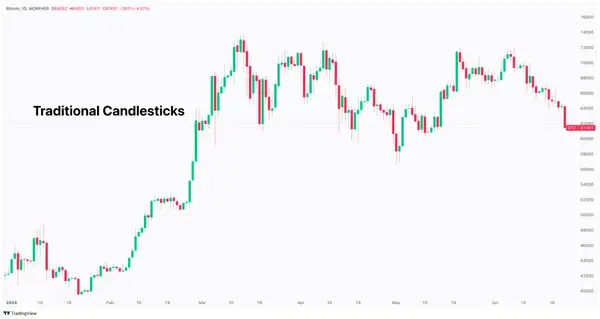
Heikin Ashi Candlestick: The open and close are averaged with the previous period's Heikin Ashi values, creating a smoother transition between candles and reducing noise.
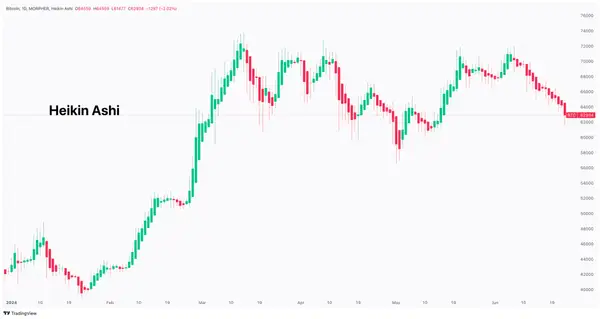
By using these calculations, Heikin Ashi candles provide a clearer indication of trends. This smoothing effect makes it easier for traders to identify potential trend reversals and maintain positions in trending markets.
Heikin Ashi Trading Strategies
Trend following strategies
As you now know, Heikin Ashi mostly helps you to identify and trade trends. Unlike traditional candlestick charts, Heikin Ashi candles serve as sort of a “Moving-Average” of charts, making them better suited for long-term trend following strategies instead of quick trading decisions.
By analyzing the chart below using Heikin-Ashi candles, we can identify two clear trends: a downtrend and an uptrend. The color of the Heikin-Ashi candles remains consistent over a given period, providing an indication of potential trend reversals when the color changes. Additionally, changes in the size of the candles and shadows offer further insight into potential market movements.
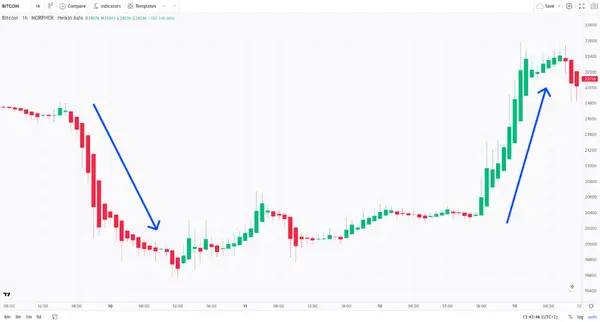
Uptrend
Let's take a closer look at the uptrend and its characteristics. Typically, an uptrend occurs after a period of consolidation or a sideways market, where the candles have smaller real bodies, resembling dojis. The first larger real body in the uptrend marks the start of an upward trend.
As the trend gains momentum, the candles become larger and have almost no shadows at the bottom. Conversely, when the candles start to decrease in size, it indicates that the upward trend may be coming to an end, and it's time to re-evaluate your position. Changing candle colors usually indicates the end of a strong upward trend for that period, signaling that it's time to exit the position.
In this case, the trend moved from 20400 to 22400, resulting in a profit of almost 10% or even more with leverage. By recognizing the characteristics of an uptrend and using them to your advantage, you can make informed trading decisions and increase your chances of achieving profitable returns.
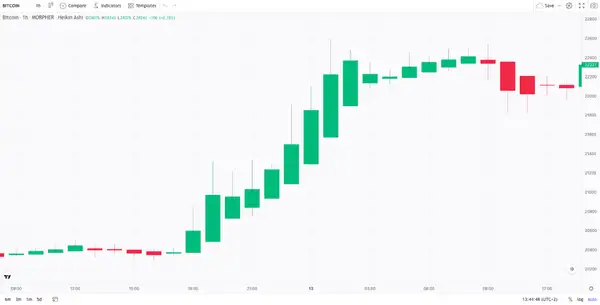
Downtrend
The downtrend is essentially the opposite of the uptrend. To identify the first indications of a strong downtrend, we look for a consolidation period in the chart, which is typically characterized by smaller real body or doji candles. The color of the candle changing is also an ideal indicator.
The first sign of a downward trend is usually a larger real body candle with no upper shadow. As the trend continues, we observe that the candles become larger and have no upper shadows, indicating that there is little pressure upwards and increasing pressure downwards, as shown by the lower shadows.
When the candles start to decrease in size, and upper shadows start to appear, it's the first indication that the trend is losing momentum, and it's time to re-evaluate your position. In this particular case, the strong downward trend began around 21700 and ended around 19900, resulting in a profit of almost 10% on a short Bitcoin position, which can be even more profitable with leverage.

Reversal trading strategies
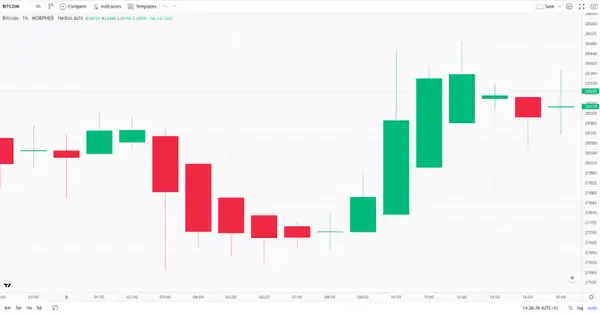
Heikin Ashi candles are particularly useful for identifying trend reversals. Let's consider an example of trading a trend reversal on the 1h chart.
The downward trend starts with a large real body red candle with a very long lower shadow. This trend is confirmed by the next candle, which is even bigger and without an upper shadow. Over the next few hours, the candles progressively become smaller, culminating in a small real body red candle with an upper shadow, indicating that a trend reversal is very likely to occur.
The trend reversal is quickly confirmed with a green long-legged doji, followed almost instantly by a big green real body candle. The upward trend continues with strong upper shadows, but eventually, the candles start to decrease in size, and the trend finishes with a small real body doji candle.
In both instances, it was possible to trade the reversal, first from 28100 to 27750 and then back up to around 28300, resulting in a profit of around 1-2% each time, which can be even more profitable with leverage.
Swing trading strategies
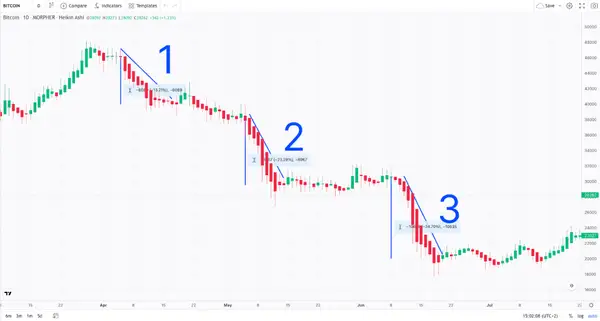
To effectively use Heikin Ashi candles for swing trading, it is important to follow certain rules to identify trends. The following rules should be kept in mind:
- A trend begins with a big real body candle, typically after a period of consolidation or sideways trading with doji candles.
- For an uptrend, the candles should not have lower shadows. Conversely, for a downtrend, the candles should not have upper shadows.
- The trend is losing momentum or ending when the candles start to become smaller and shadows appear from both sides.
Let's take a look at how these trading rules play out on a live chart and compare it to a chart with normal candles. In the example below, we examine the first downtrend from the chart above. The left chart shows the downtrend with normal candlesticks, while the right chart shows the downtrend with Heikin-Ashi candles.
On the Heikin-Ashi chart, you can clearly apply all the trading rules discussed earlier. The downtrend is confirmed with a big red candle without an upper shadow, followed by multiple similar candles. Finally, we exit the trade once the candles start to become smaller and shadows appear on both sides. However, on the chart with normal candles, you cannot apply these same rules as it is filled with green candles in between.
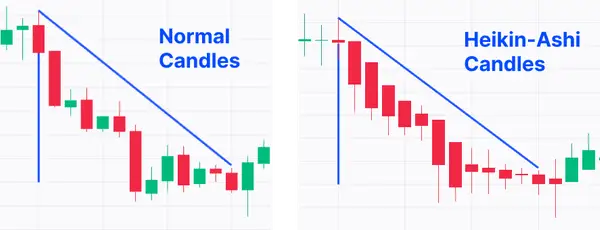
The same rules apply to the other two downtrends shown on the chart above. By trading simply by looking at the Heikin-Ashi candles, you could have made three easy and profitable trades. The first short would have given you around 13%, the second short around 23%, and the last one a whopping 34%. With leverage, you could have made an even bigger profit on such an easy strategy.
Conclusion
In conclusion, we've delved into the world of Heikin Ashi charts and explored the unique benefits they can bring to your toolkit. We started by defining what Heikin Ashi candles are and how they differ from traditional candlesticks, highlighting their ability to filter out market noise and present a clearer picture of price action.
We then discussed the various characteristics of Heikin Ashi candles, such as their trend-following nature and ability to identify potential trend reversals and entry/exit points for trades. We also explored some of the advantages of using Heikin Ashi candles in different trading strategies, such as trend-following strategies, reversal trading strategies, and swing trading strategies.
By understanding the unique characteristics and advantages of Heikin Ashi candles, you can gain a clearer picture of price action and make more informed trading decisions. So go ahead and explore the world of Heikin Ashi charts – you never know, it could be the missing piece to your trading strategy puzzle.

Disclaimer: All investments involve risk, and the past performance of a security, industry, sector, market, financial product, trading strategy, or individual’s trading does not guarantee future results or returns. Investors are fully responsible for any investment decisions they make. Such decisions should be based solely on an evaluation of their financial circumstances, investment objectives, risk tolerance, and liquidity needs. This post does not constitute investment advice.

Painless trading for everyone
Hundreds of markets all in one place - Apple, Bitcoin, Gold, Watches, NFTs, Sneakers and so much more.

Painless trading for everyone
Hundreds of markets all in one place - Apple, Bitcoin, Gold, Watches, NFTs, Sneakers and so much more.

